JOUSTRA DIACLONE AMBULANCE (RATCHET)
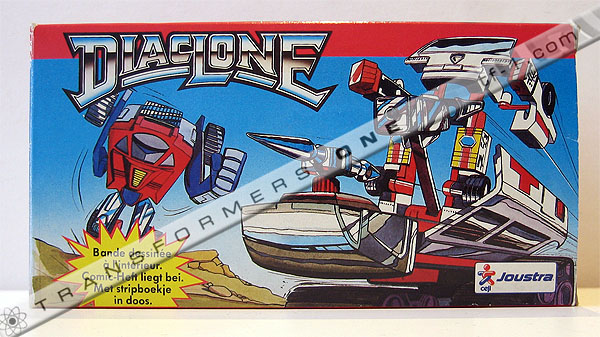
You would be forgiven for thinking the Ceji Joustra "Diaclone" Ambulance, from wave 1 of these awesome European Takara-licenced pre-Transformers, is one of the least interesting of the bunch. It's not a different colour, it doesn't have a major variation and it's not limited edition. It's not even particularly rare, with probably only the Joustra Porsche 935 (pre-Jazz) being more available on the second-hand market. But time and again, it isn't the toy itself that makes Joustra releases interesting, it's everything but the toy which has afforded Joustra Diaclones the fame and affection they now command.
The Joustra Ambulance announces its arrival with a breathtakingly colourful, striking and unforgettable box front illustration courtesy of artist twins Paul and Gaetan Brizzi. Sold throughout Europe in 1984 and 1985, it also features the Joustra Pick-Up (Gears) very prominently on the box front, a mystery that had before this year yet to be satisfactorially solved.
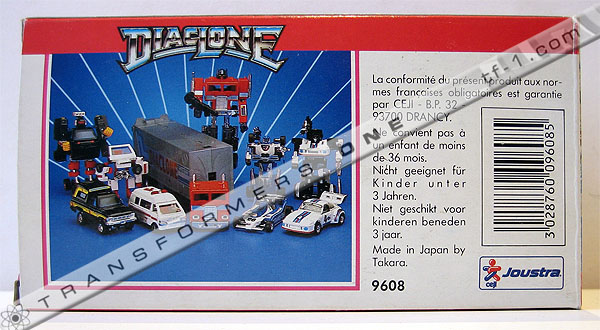
Being from the first wave of Ceji Joustra releases, the Ambulance features only stock photography of Japanese Diaclone Car Robots on the back of the box. Wave 2 Joustra toys would have a cellophane window actually showing off the toy, making them slightly more exotic and interesting than these first wave toys. But wave 1 is what introduced the collecting world to these supremely exclusive toys and their unique art and characterisation. You can see Ambulance's 9608 assortment number clearly visible on the above box back image.
The feauturing of Japanese Diaclones with strange accessories and states of mid-transformation on Joustra packaging have been documented thoroughly on this site and others already, and with that in mind, you may be able to spot the second item of interest on our tour.
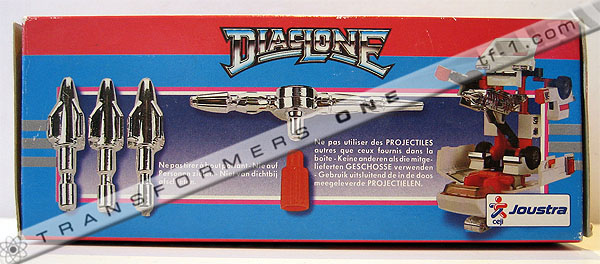
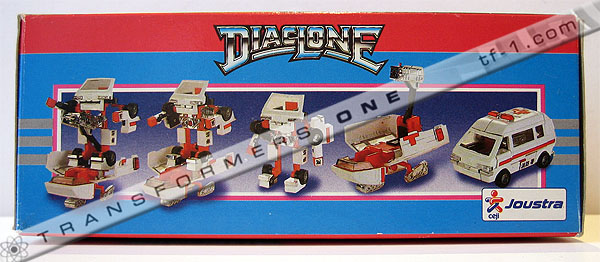
The Ambulance on the packaging is clearly a Japanese Diaclone Onebox Ambulance, this is given away by the Japanese lettering on the side of the vehicle. You may also notice that the hands have not been fully rotated for transformation in robot mode, and the red peg + silver attachment have not been connected to the base. Here's a closer look at the Japanese lettering on the side of the stock Diaclone Onebox Ambulance:
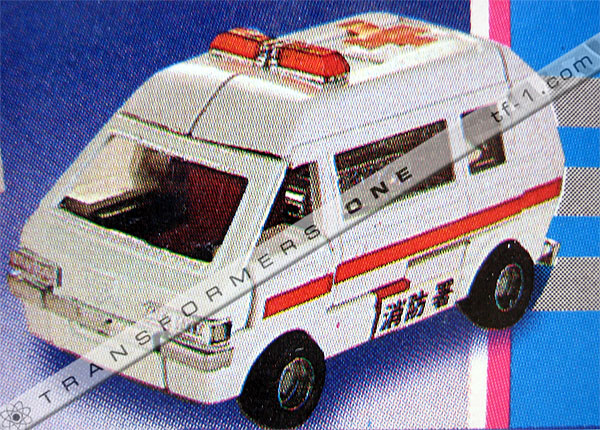
Looking at the sides of the box, you may notice that it appears taller than most Joustra car boxes, and that is because this mould typically had taller styro to accomodate the height of the vehicle and associated accessories and paperwork. The use of a Japanese Diaclone for stock photography is further evident in the following pictures as well.
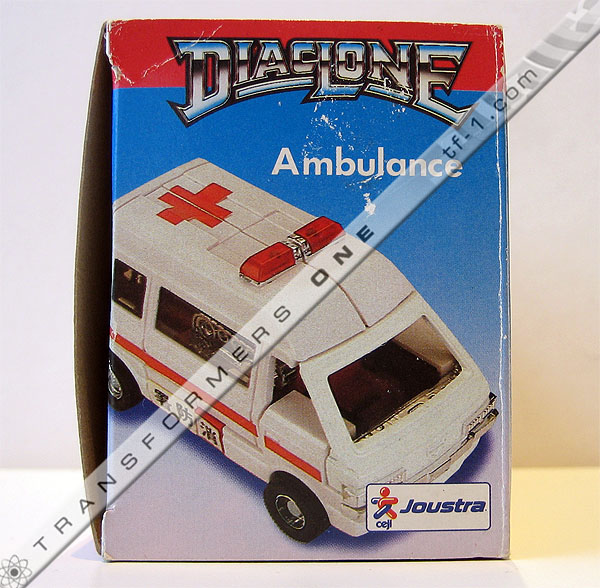
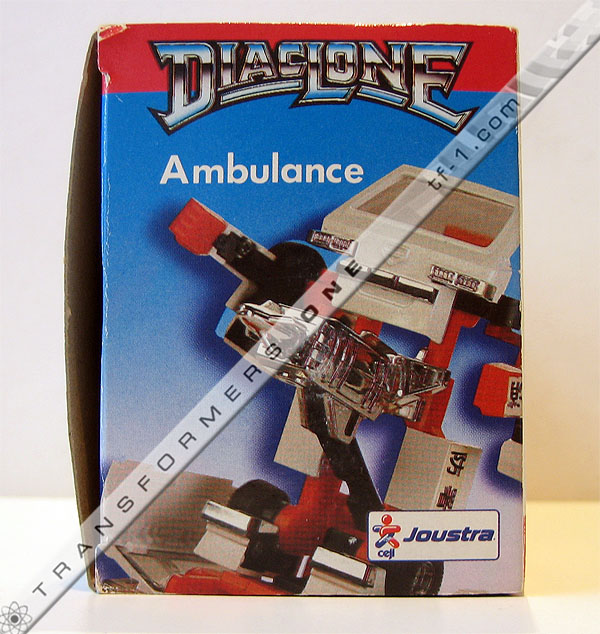
As seen in the case of the Joustra Toyota 4x4 and F15, the use of a Japanese Diaclone on this Joustra Ambulance's packaging is also mirrored in the mini catalogue/comic accompanying the wave 1 releases. You can see below that the Ambulance featured in the aforementioned comic also has the Japanese lettering on the toys, most notably on the robot mode Ambulance's left hand:
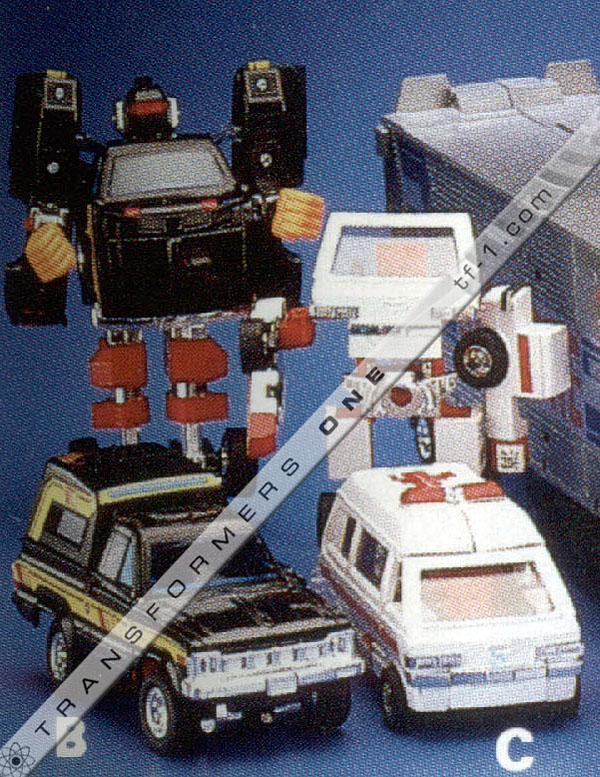
To prove the above statements, here is the original first release of this specific mould variation, the Takara Diaclone Car Robot No.4 Onebox Ambulance Type:
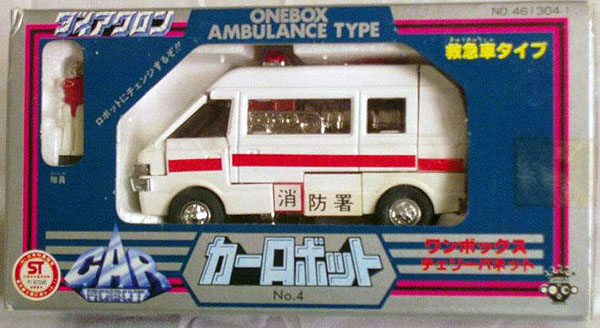
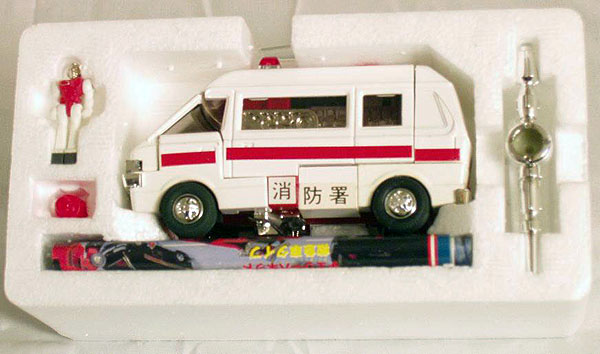
You can begin to see why the styro is taller for this toy, a huge space has been reserved for the large amount of folded paperwork the Japanese release came with, as well as the vertical placement of the silver weapon-like attachment. The Japanese writing is clearly visible on the side of the Diaclone Onebox Ambulance above. You may also notice how detailed and differently-moulded the hubcaps are on the Japanese Diaclone compared to the more simplified hubcaps on the later-mould Japanese Ambulance and the Italian GiG pre-Transformers version of the same Diaclone-style release below:
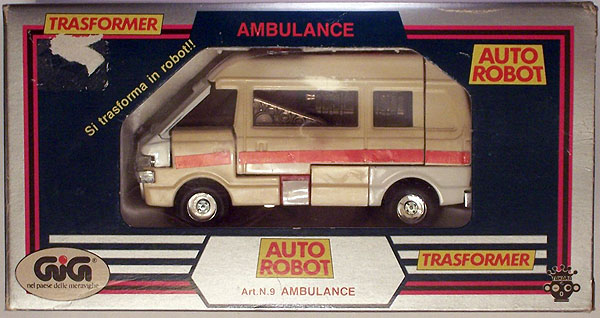
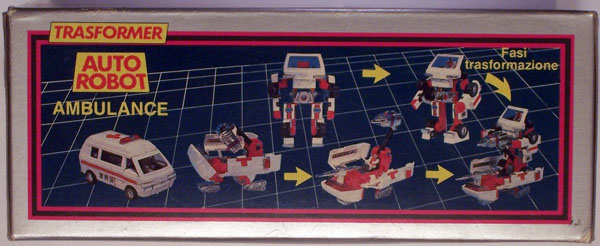
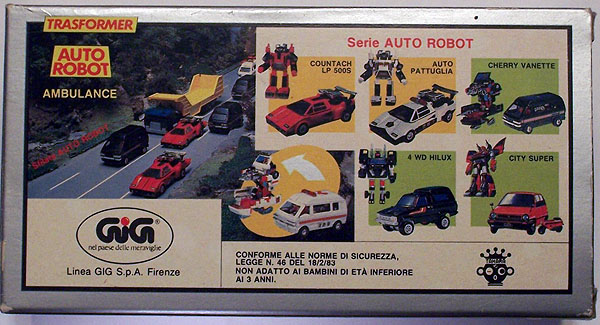
This GiG TraSformer version of the Diaclone does not feature the Japanese writing on the vehicle, shows considerably less intricately-moulded hubcaps, but still features the original Diaclone Onebox Ambulance, writing and all, on its packaging. Earlier GiG Ambulances have been found with the Japanese lettering on the vehicle. You can also see a nice Diaclone Toyota Hilux prototype (see its side stickers) and proto artwork for the red Honda City R on the GiG box back, which of course mirrors the Japanese box back. Just to go back to the hubcaps, you may wish to look again at the Japanese Diaclone pictured on the Joustra box. It actually has simple hubcaps, but the one featured in the Joustra mini catalogue (robot mode) has complex hubcaps even though the vehicle mode Ambulance in the catalogue has simple hubs. This shows that Takara sent Ceji Joustra earlier and later variants of this model.
While the styrofoam insert did not change from Japanese Diaclone to GiG pre-TF or Joustra Diaclone, the Diaclone driver was omitted for most Italian and all Joustra releases and so that styro space in the top left corner was left unoccupied. This was still evident for the 1985 European Milton Bradley release of the Transformers Ratchet which eventually replaced the Joustra Ambulance on shelves in France, Belgium, Holland, Germany, Austria etc (Source HERE)
The Ambulance has now become the Autobot Medic "Ratchet". The styro used in MB TF Autobot car releases had to be held in place by cardboard insert supports, and since Ratchet's was the biggest styro, the supports were moulded to fit Ratchet snugly. The other MB cars' styro would sit a little less flush against these uniform MB cardboard supports. Obviously, no Diaclone driver was included for the Transformers release either and the styro space beneath the vehicle in the styro features no Diaclone paperwork.
You can see just how odd those Milton Bradley releases were by comparing them to a 1984 US Transformers Ratchet MISB:
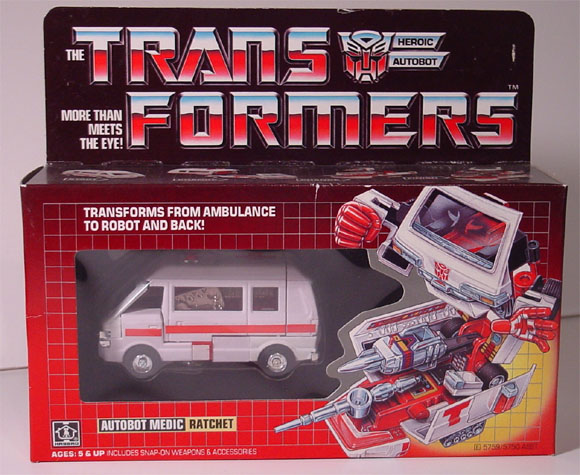
A more commonly-used bubble insert is evident on the US release, but notice how Ratchet's Transformers artwork features a red cross on his open left palm. This was not seen on all Transformers Ratchet artwork as verified by the MB packaging just before the US TF image above.
Interestingly, the reason for some TF Ratchet art featuring this red cross on his palm originates from the fact that the original Diaclone had the Japanese lettering on the side of the vehicle, and of course to transform this toy fully you must rotate the wrists so that the square white sticker with the Japanese lettering becomes the palm of the Diaclone robot's hand. Transformers packaging was originally altered to not show this Japanese lettering, and instead the stock photography on TF Ratchet's box shows a red cross on the side of the vehicle. When you fully transform this "proto/mockup" TF Ratchet, that square red/white cross sticker becomes his robot palm. Hence the red-cross-on-palm artwork. Just as the later Ratchet boxart was amended to not have the red cross-on-palm, the stock photography was also amended to not show that red cross on the vehicle side or robot hand, since no version of TF Ratchet ever came with that little red cross sticker on the side of the vehicle.
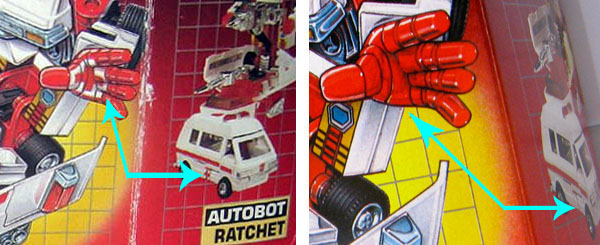
It should also be clarified that Transformers Ratchet was available in the US, UK and Canada in 1984 before the MB Transformers were launched in Europe in 1985 or indeed by Takara in Japan in 1985.
On the subject of the Japanese Transformers release of Ratchet, he was never available in Japanese stores. Ratchet was only available in Japan by mail order in 1986. This is an extremely interesting and popular release as the artwork used for the Japanese TF Ratchet does not depict the Diaclone mecha-style medical base robot, it uses the cartoon/anime version of Ratchet which underwent considerable personification for comics and television:
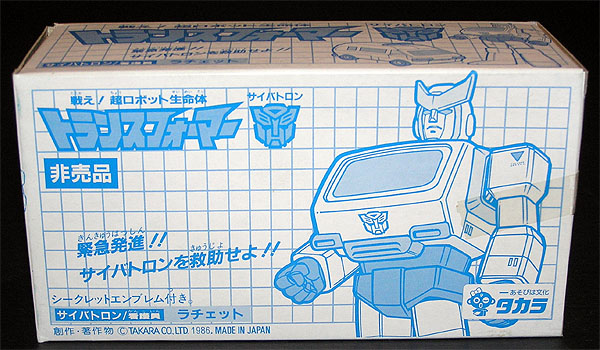
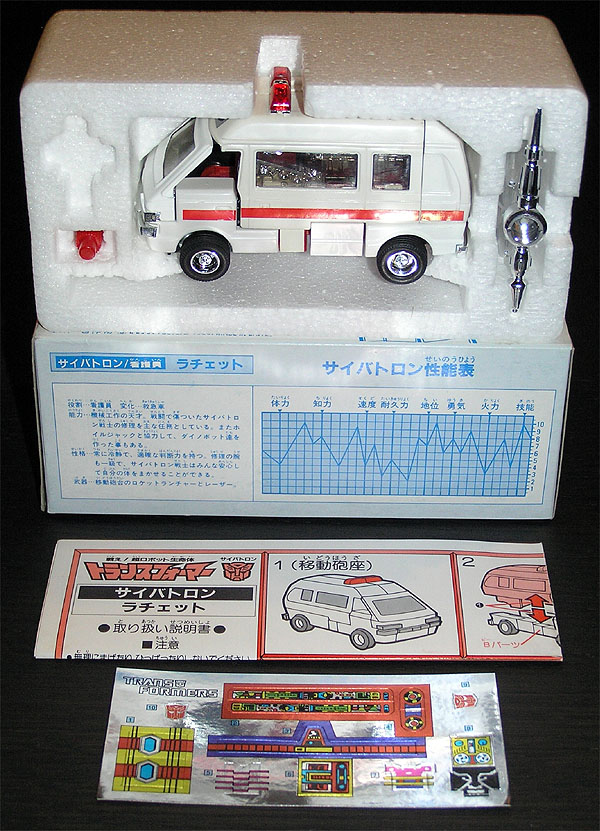
Notice that this release still features the Diaclone styro, and unlike many Japanese Transformers Autobot cars, the space for the Diaclone driver still remains! The shape and size of the paperwork indicates that again it would not have come stored in the styro space beneath the vehicle, but outside of the styrofoam.
Let's return now to the Ceji Joustra Diaclone Ambulance from Europe, and examine the attention-grabbing exclusive artwork on the front of the box:
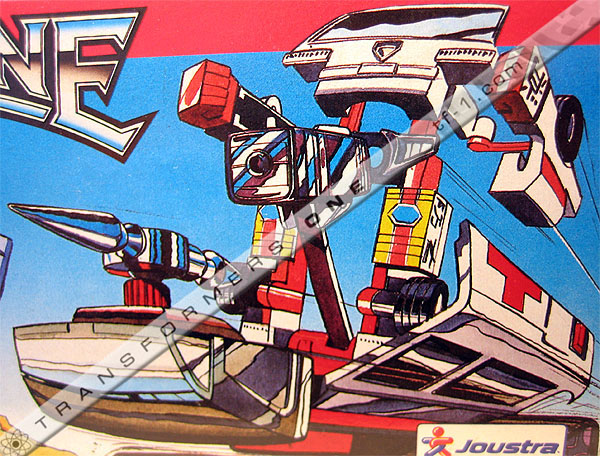
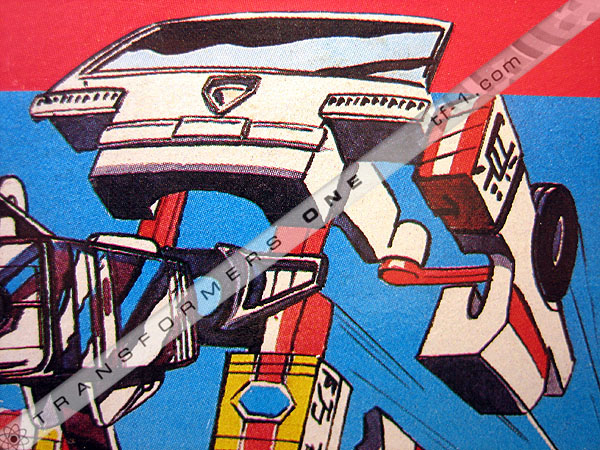
As if we needed any further convincing that Takara sent Ceji Joustra samples of Japanese Diaclone toys to produce their packaging and paperwork, the Brizzi artwork for Ambulance shows clearly the Japanese lettering on side of the vehicle and hands specific to the original Diaclone release of the Onebox Ambulance. In my opinion, it's quite a feat to have made a literally faceless figure seem so appealing. To be fair, this figure has had some great things done with its artwork over the years, from the Japanese mail-away cartoon art to the Transformers artwork used in the US and Europe, and of course the Joustra interpretation.
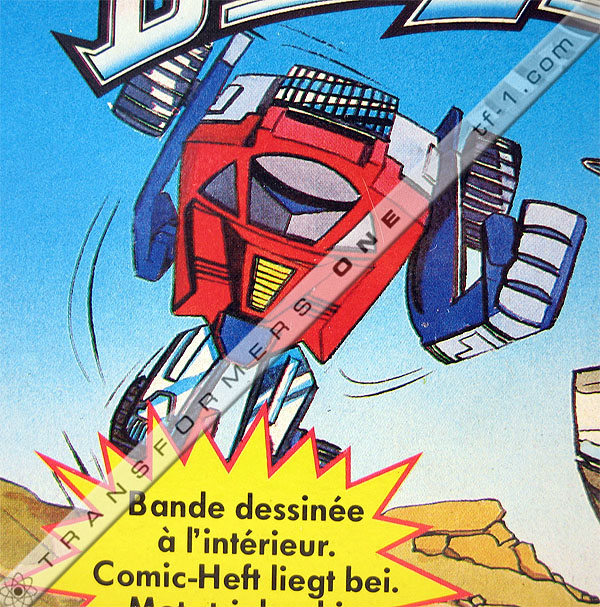
And then there's this little mystery again. The sharing of its box front with the Joustra Pick-Up (Gears) could have led children and their parents to believe that the Ambulance toy would come packaged with an extra toy! Would buyers originally have thought that the slightly larger Ambulance packaging was due to an extra minibot inside? They would have been sorely disappointed if that was the case as the Joustra Ambulance does not come with a Pick-Up. The stock photography on the Joustra Ambulance box back/top/sides/bottom does not suggest anything else inside the package apart from the Ambulance alone, of course. Seeing as how the Pick-Up is featured right above the yellow action bubble advertising the comic, you might think that's where the relationship must originate, as wave 1 Joustra artwork is always lifted from the accompanying comic strip. The Pick-Up could easily have just been added to Ambulance's artwork for no other reason but dynamic effect.
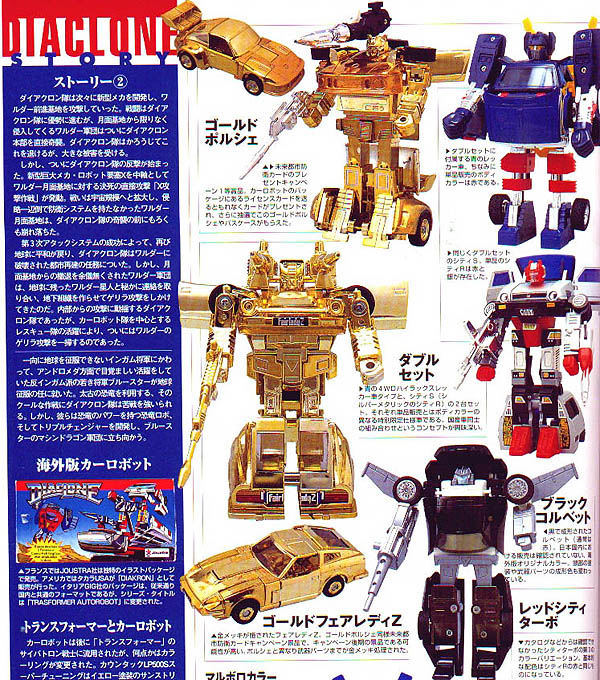
Finally, before moving on to the toy itself, you will see above an excerpt from the "History of Diaclone" feature in issue #2 of the Japanese magazine "Gangu Jinsei". Understandably, the Finnish Black Corvette, gold campaign cars and rare Diaclone recolours steal the attention usually, but on the left you will see an image of the Joustra Ambulance representing a small passage referring to foreign Diaclone-inspired releases such as GiG TraSformers, Joustra Diaclones and American Diakron toys. Any surprise that they chose to show the Joustra artwork above a GiG or Diakron box front?
So what's inside this box, anyway?
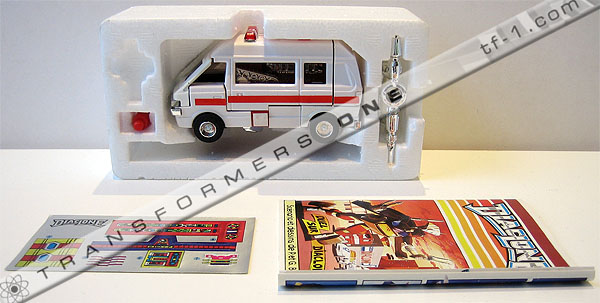
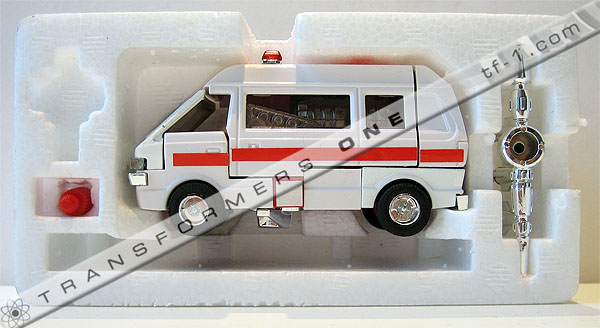
Confirming its chronological place in the grand scheme of things, the Joustra Ambulance insert features the exact same styrofoam seen in the earlier Japanese Diaclone and later MB Transformers Ratchet. There is no Diaclone driver, no Diaclone paperwork in the styro space beneath the vehicle and the Ambulance itself has the simpler wheelhub moulding. Further compunding the lies told by the packaging artwork, there is no Japanese lettering on the side of the vehicle and certainly no Joustra Pick-Up anywhere to be found.
But enough about what's missing, how about the beautiful exclusive comic/catalogue, Joustra-specific stickersheet and accessories:
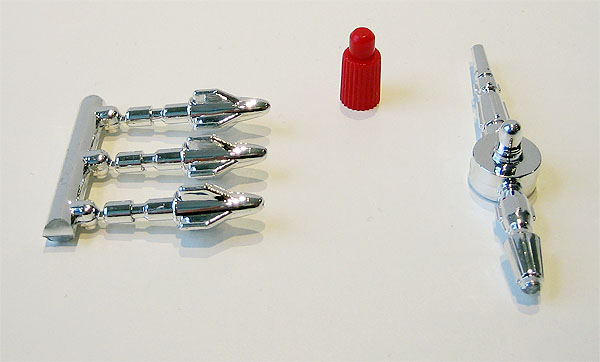
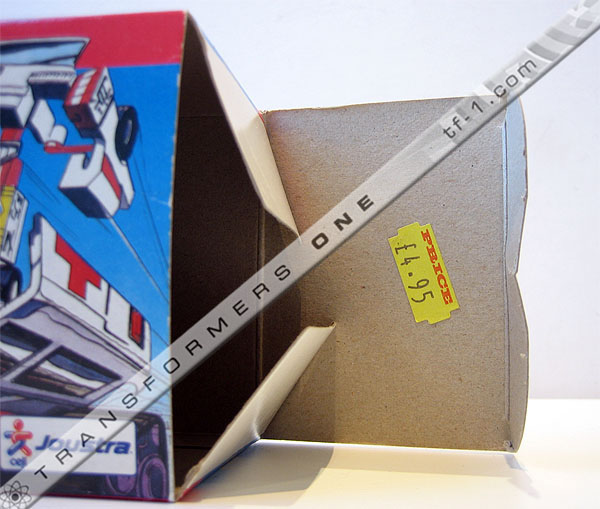
Typically, Joustra Ambulance shows a lot of chromed accessories (as well as parts) as was stylistically popular at the time of Diaclone and early Transformers. The inside of the box flap reveals a UK price sticker to the value of £4.95. I am not for one moment suggesting that this item was originally sold in the UK, or that I paid £4.95! It is interesting though as I did pick this item up from eBay UK, so at some point it was bought in Europe then brought back to the UK, and possibly sold in a second-hand or charity shop.
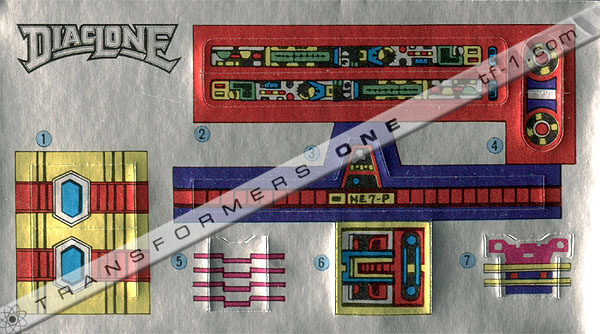
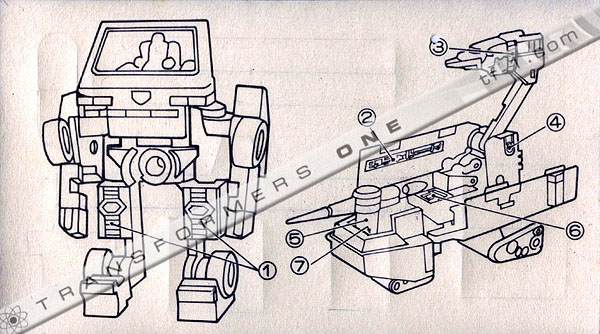
The Joustra Ambulance stickersheet shows the Joustra-specific Diaclone-style logo on the top left corner as opposed to the Japanese lettering evident on Takara and GiG releases of the mould. Notice the lack of a sticker for the robot 'face', which you would have gotten with TF Ratchet stickersheets. The back of Ambulance's stickersheet features the sticker placement map, again specific to Joustra Diaclone releases. This was done to save printing costs on instructions.
Story time.
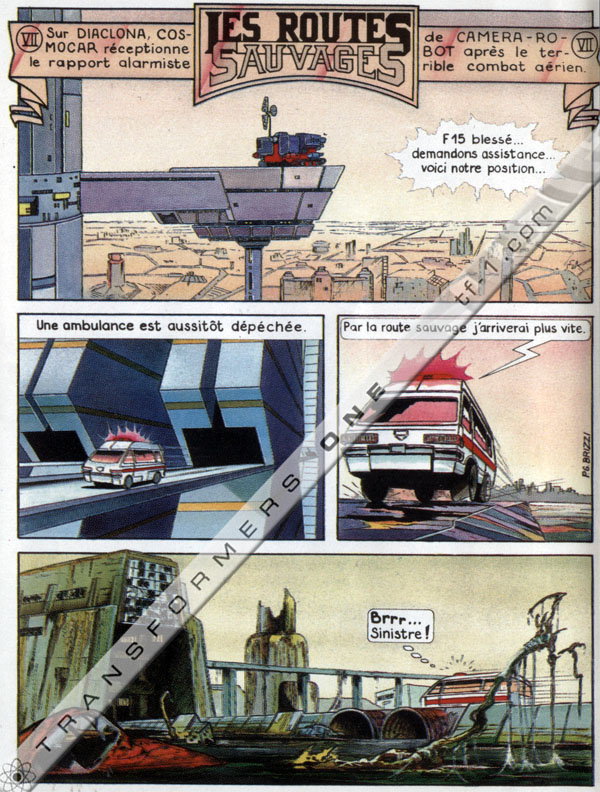
"CHAPTER VII: WILD ROADS - On Diaclona, COSMOCAR receives an alarm report from CAMERA-ROBOT after the terrible air combat"
Camera-Robot: "F15 is hurt...assistance required...here are our coordinates..."
"An Ambulance is immediately dispatched."
Ambulance: "On the savage road I'll get there faster."
Ambulance: "Brrr..sinister!"
This chapter follows on immediately from Chapter 6 where the Joustra F15 (Starscream) and Camera Robot (Reflector) found Multiforce14's secret base but were ambushed, and F15 gets hurt. The logic behind the individual comic chapters and the immediate continuation of the story in the following chapter is a significant tool in trying to discover what happened in the chapters not yet found or documented. More on this shortly...
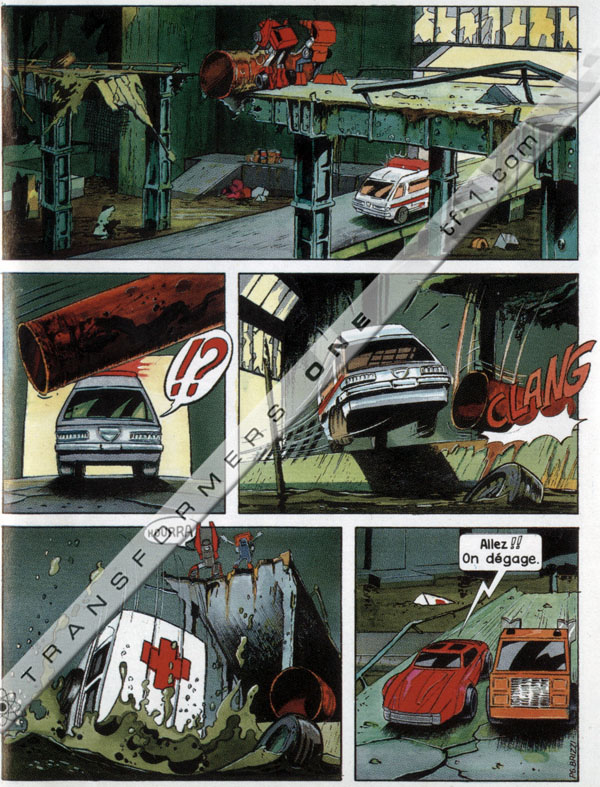
Trans-Am: "HOURRA"
Trans-Am: "Go! Let's beat it."
Quite a stunning development here. Of all the documented released Joustra comics so far, this is the first discovered appearance of the minibots, the same minibots always associated with good (Autobots) and actually packaged by Ceji Joustra featuring Autobot stickers. So how surprised I was to see Trans-Am (Windcharger) and Truck (Huffer) launch a surprise assault on the Ambulance and celebrate his apparent demise, although on escape they did expect him to surface again.
Unfortunately, the comic containing the card art for the minibots (and probably their actual first appearance and introduction) has not yet surfaced, so the nature of their involvement with the bad guys, assuming all minibots are together, is unclear. What makes it even stranger is that the carded toys did not come with comics, and there aren't enough releases left in wave 1 Joustra to account for the missing chapters. It is a remote possibility that one or more of missing comic chapters 2 & 3 may have been a give-away, mail-away, store excusive, retail incentive or promotional prize of some sort. Or maybe they just never saw release.
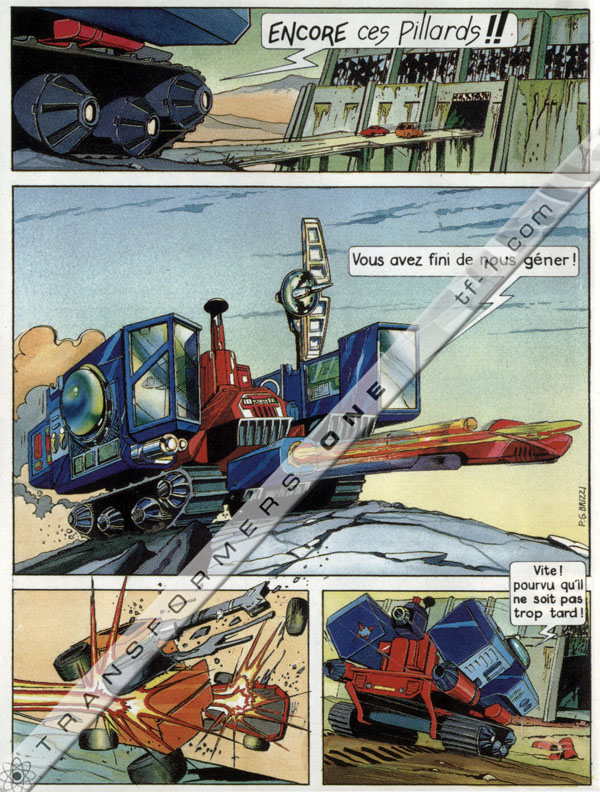
Cosmocar: "These plunderers again!!"
Cosmocar: "You're done being in our way!"
Cosmocar: "Hurry! Hope it's not too late!"
In keeping with the general theme of the comics, as with Chapter 9 where Roller was terminated and Chapter 4 where some of the Dashers met their end, in this chapter the villains Trans-Am and Truck are disposed of by the formidable Cosmocar. You can see this last section contains the boxart for Cosmocar in the centre panel, so it's fair to say that toy comes with this same comic chapter. One of the only villains thus far that hasn't been killed is Multiforce14 and its components, whose defeat was saved for comic chapter 10.
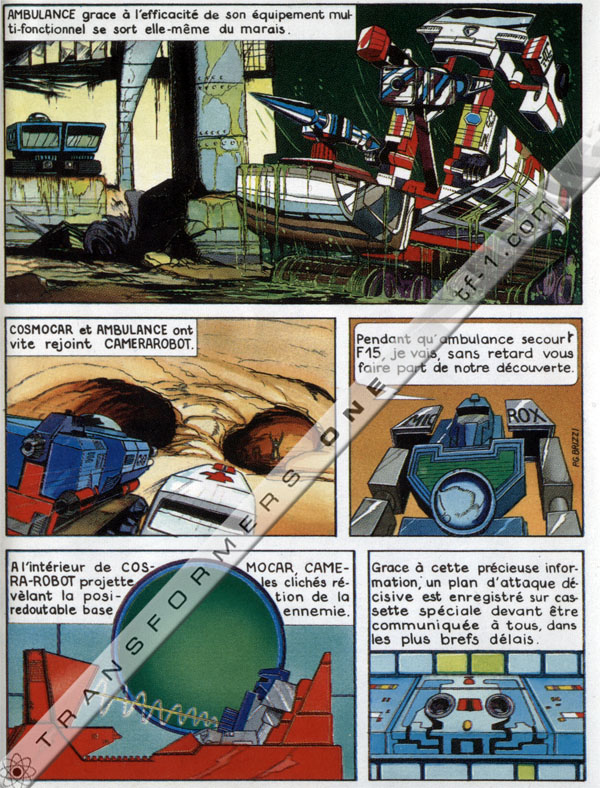
"Thanks to her efficient multi-functional equipment, Ambulance is able to get herself out of the marsh."
"COSMOCAR and AMBULANCE quickly joined CAMERA ROBOT."
Camera Robot: "While Ambulance helps F15, I will without delay inform you of our discovery."
"Inside COSMOCAR, CAMERA-ROBOT projects the image revealing the position of the fearsome enemy base."
"Thanks to this valuable information, a decisive plan of attack is recorded on a special cassette to be sent to everyone as soon as possible."
The major thing here is that the Joustra Ambulance is revealed to be feminine! Thanks to help from Detour with the translation, I've updated the transcript above.
This chapter sets the scene very nicely for the next section of the story which features Condor (Laserbeak) and Robocolt (Browning) called "Traitor". This has been one of the more interesting sections of the comic for me so far, seeing what amounts to Ratchet and Cosmo Roller rescuing Reflector and Thundercracker from Windcharger and Huffer! As a child, these stories would have had a huge effect on how you saw your toy, just as the Transformers cartoon affected so many people's feelings about particular Autobots or Decepticons.
Now to the toy:
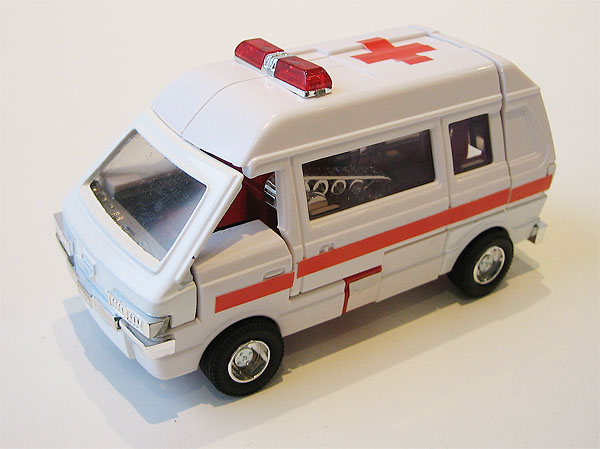
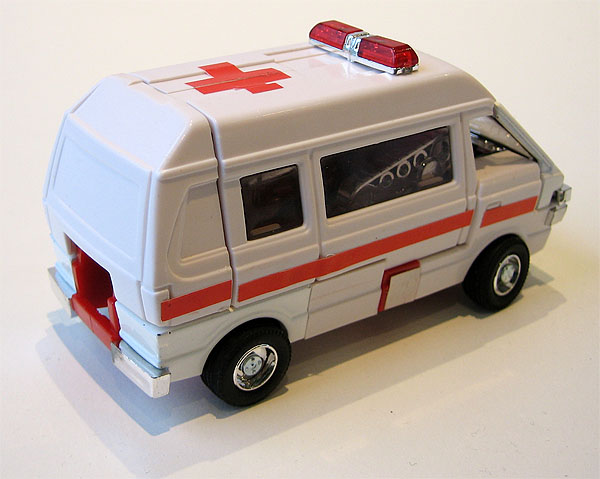
An unused, un-transformed and undamaged Ambulance/Ratchet is a very nice sight indeed. A very clean appearance with a high-visibility (but not day-glo) and universally recogniseable colour scheme. This mould features a little bit less visible chrome in vehicle mode, not counting the treads seen through the windows, but what there is complements the overall look quite nicely. It is a bit of a shame that instead of the Japanese lettering on the sides, they didn't actually go with the stock Transformers mock-up idea of having a small red cross logo on the small square white sticker.
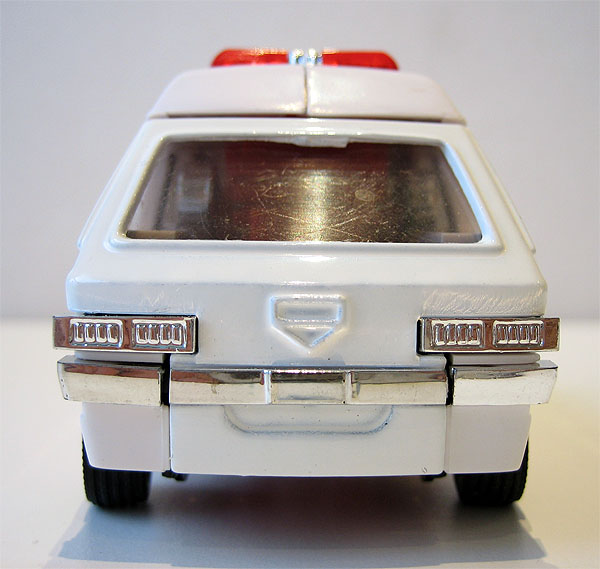
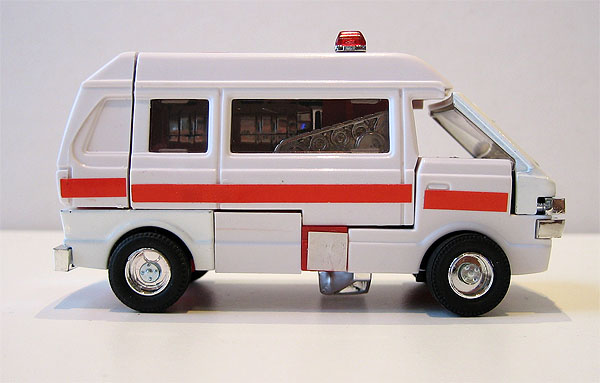
A very under-appreciated mould in my opinion, mainly because of the lack of closeness to the Transformers Ratchet cartoon character in robot mode, the vehicle mode of this toy is quite attractive and one that has grown on me immensely. You can of course see very clearly the number of wear possibilities on a used sample, including chrome and factory sticker wear. Paint chips on the painted diecast sections will also present problems, even for minty samples like this.
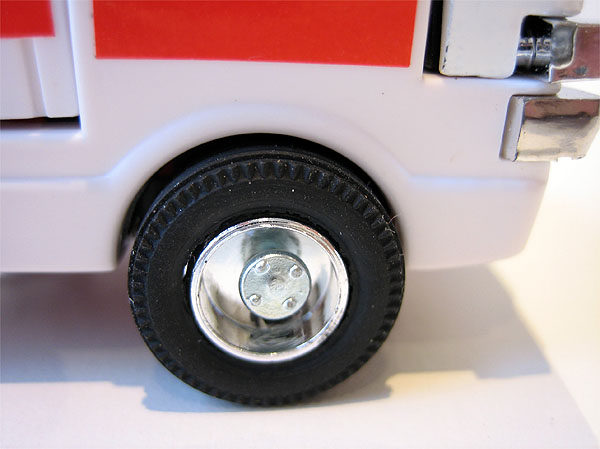
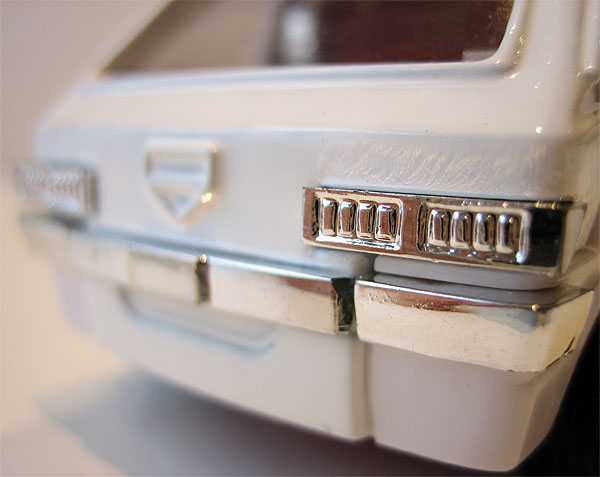
Above you can see close-ups of the now-simpler hubcap moulding and the chrome lights and bumper sections on the front of the Ambulance. It should be mentioned that while it may not be a hugely accurate representation of the actual Nissan Cherry Vanette, it's better looking than the real thing!
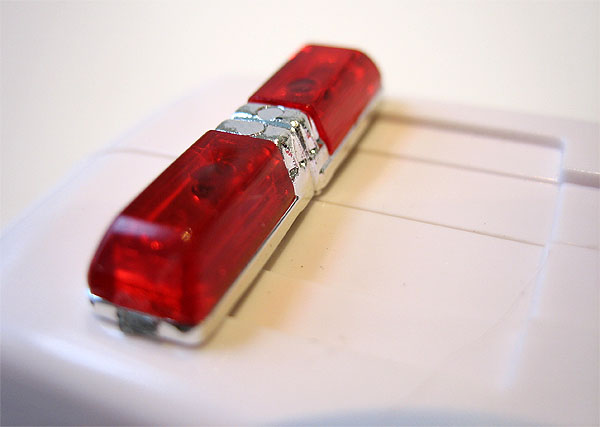
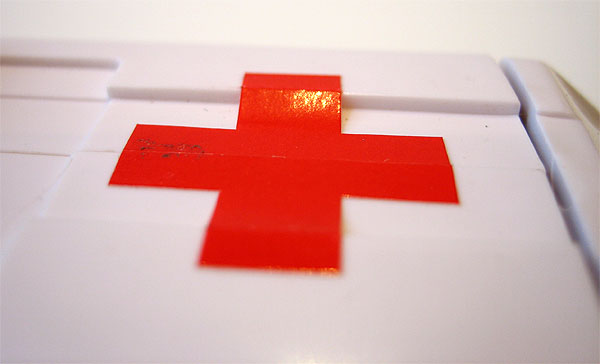
The sirens on this Ambulance mould are not the same as the Fairlady Police or Police Countach sirens as on this mould the lights need to split when the two halves of the van open up during transformation. You can also see the large red cross sticker on the roof of the vehicle. Even a mint sample such as this shows areas where the sticker is not in contact with the plastic. That sticker is also designed to split when the rear section of the van opens.
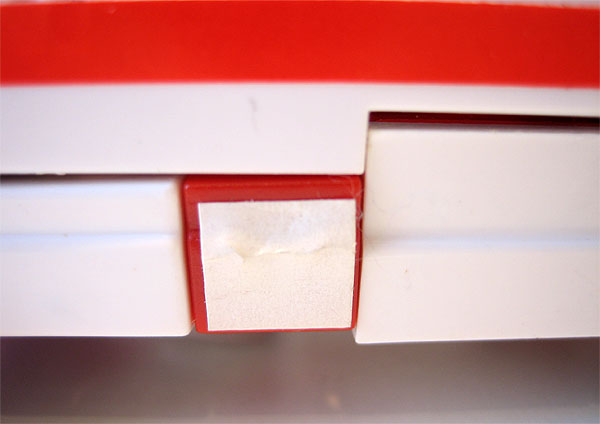
This is the square white sticker I've referred to a number of times already. The Japanese Diaclone would have had Japanese writing on that square sticker, the Transformers packaging mock-up had a red cross on it. Actual Transformers, most GiG Diaclones and the Joustra Ambulance have a plain white sticker.
Separating the rear section from the front of the Ambulance and opening it up reveals the medical base section of the toy:
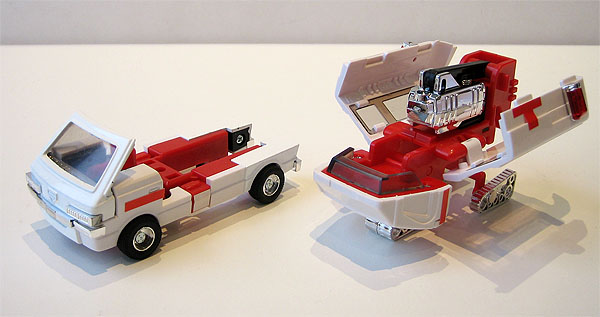
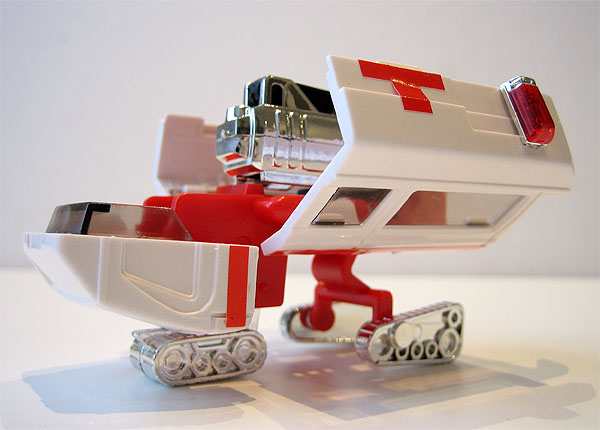
With the treads deployed and the missile launcher exposed, a considerable amount of chrome is added to the overall look, and throughout the articles on this site I have expressed my affinity for chrome regularly.
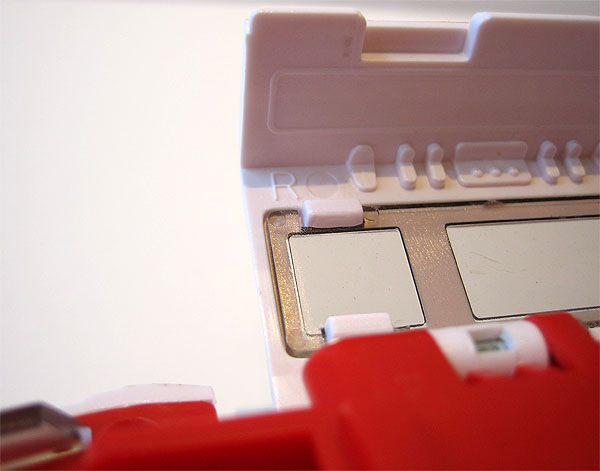
On the inside panels of the base section of the unit, there are "R" and "L" letters moulded into the plastic, more than likely added for assembly purposes than for the benefit of those purchasing the toy.
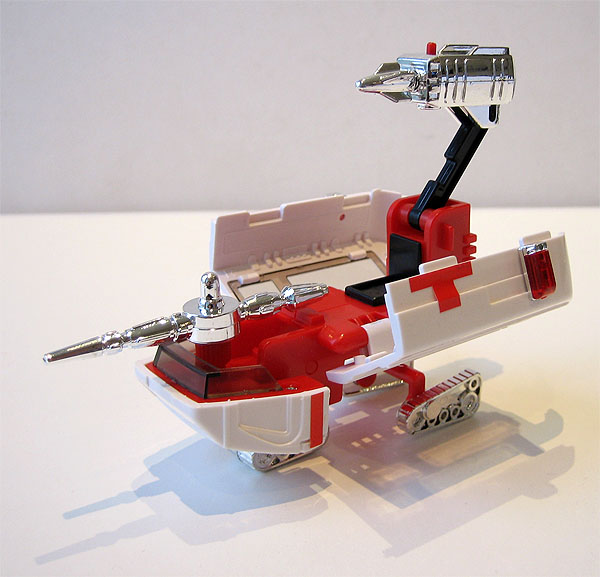
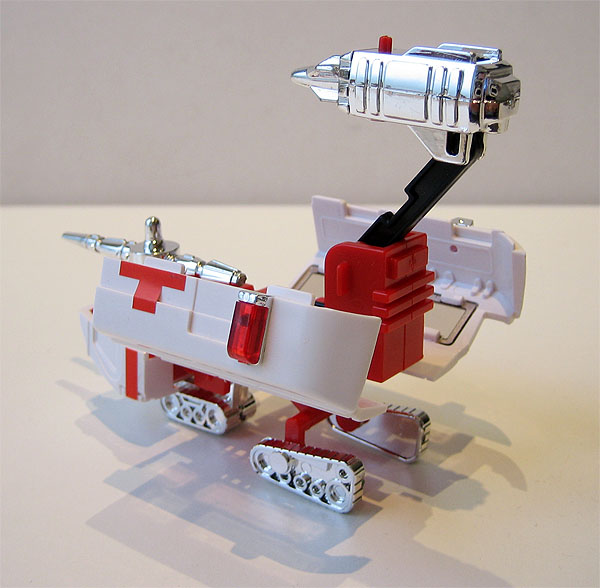
It's sometimes difficult to remember that originally the purpose of this mould was to be a medical unit piloted by a Diaclone driver, so the design never had to take into account a robot head and humanoid poseability. The Joustra Ambulance is more akin to the Transformers Ratchet than the Onebox Ambulance Type as it is actually portrayed as a sentient character in a story, and so maybe suffers from the same lack of particular features that Transformers Ratchet does. Having said that, the red, white and chrome meld together beautifully to present a visual treat.
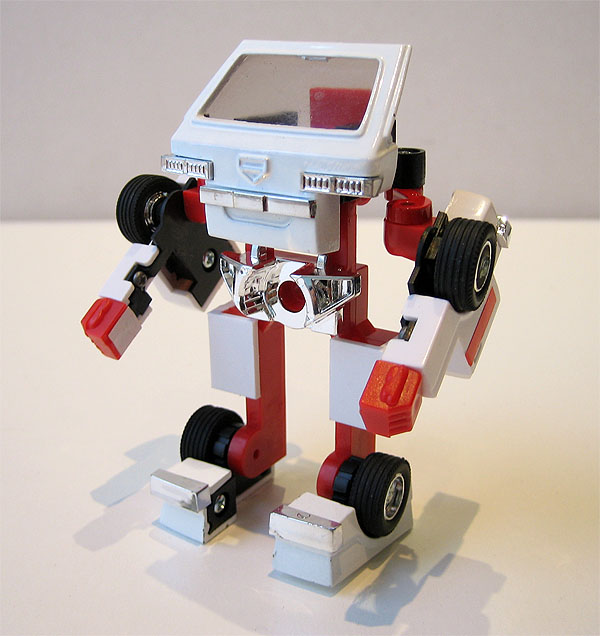
Despite the fact that the robot section of the transformed Ambulance is not completely intended to be a stand-alone character or figure, the arms, legs and waist are of quite decent proportion. It really needs to be imagined with a small Diaclone pilot seated behind the main windshield. Unlike the stock photography, the correct transformation requires the fists to be rotated with the square white sticker facing inwards, indicated by the thumb of the closed fist appearing on top in this configuration:
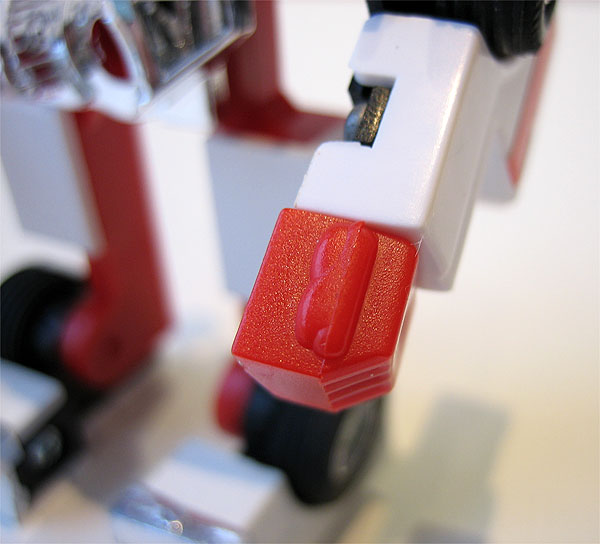
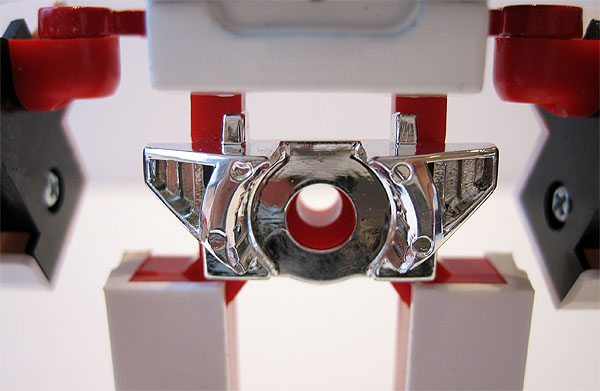
This quite splendid chrome waist piece seen on the figure mode of the Ambulance can be removed and added to the peg/weapon assembly for the base section as seen below in two of a few possible configurations:
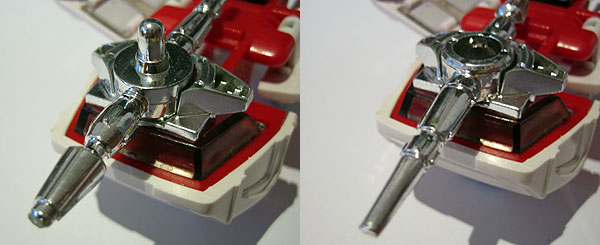
However, the real piece de resistance of this Joustra Ambulance is the fully 'combined' mode of the robot figure standing on the medical base unit with all attachments connected and loaded. The sea of chrome weaponry indicates that this is far from just a simple medical unit.
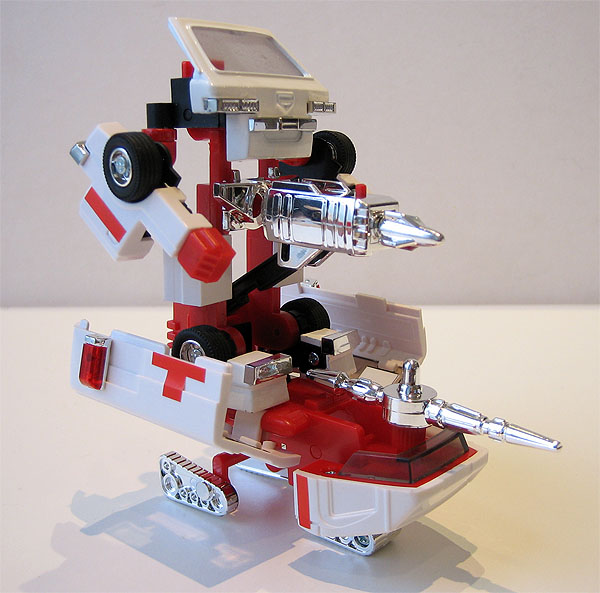
Beautiful, very impressive indeed. I've always said that collecting Joustra Diaclones has finally allowed me the opportunity to own these original moulds in all their glory, and seeing this Ambulance toy in the condition it was created in has made me appreciate it more than ever before as I had never previously owned the Onebox mould amazingly.
Some close-ups in figure mode:
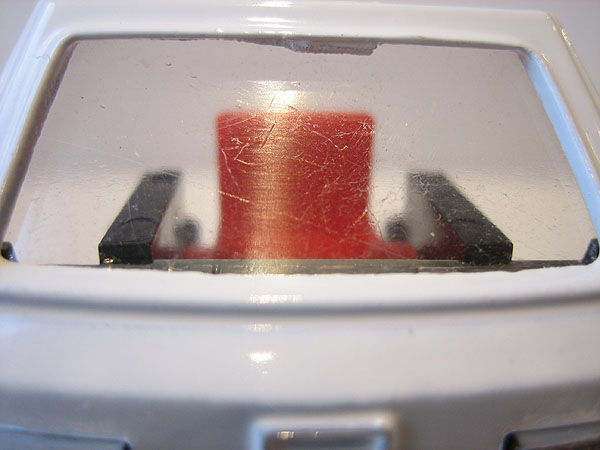
No robot face in this version of the mould, just an empty seat where there used to be a Diaclone pilot.
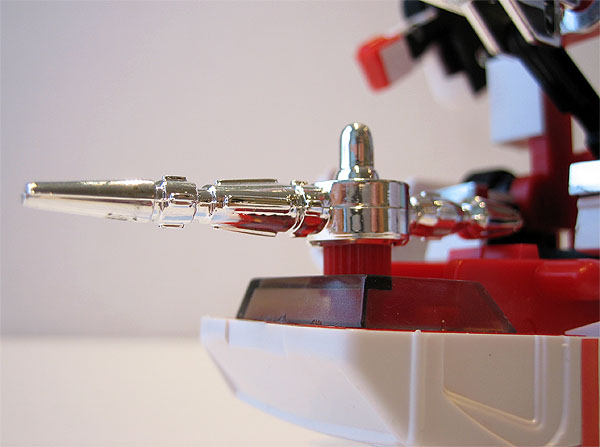
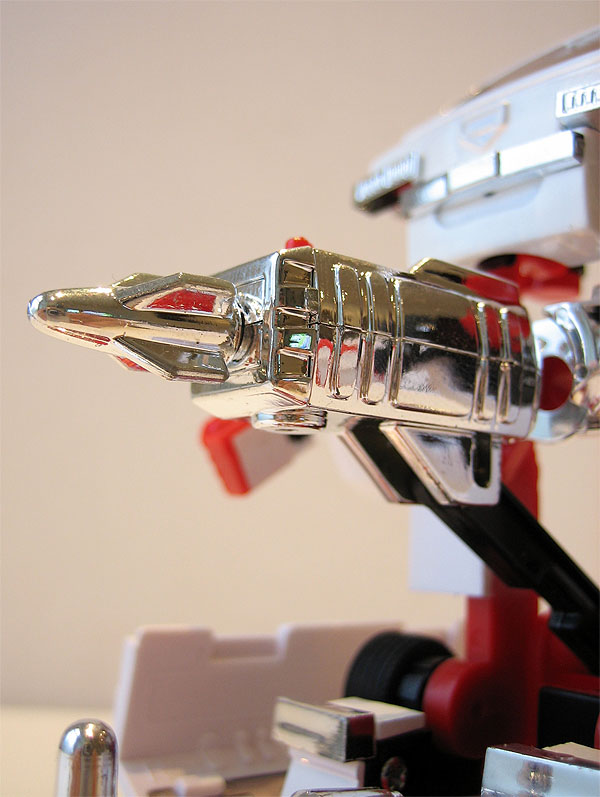
The combination of a powerful unaltered launching mechanism and a small lightweight missile equals respectable firing distances! Even if this alternate mode doesn't quite qualify as a robot, it's got so much going for it and a great deal to draw and keep the attention of a child and adult collector alike. This is a thoroughly displayable toy in either mode, moreso in this mode than vehicle mode though for sure. This is not something I would have anticipated having bought the Joustra Ambulance originally.
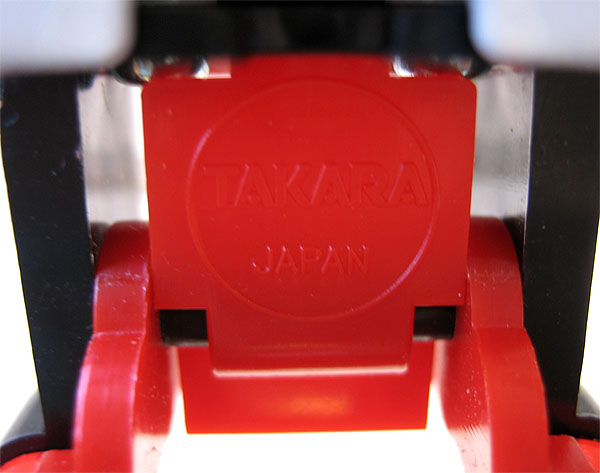
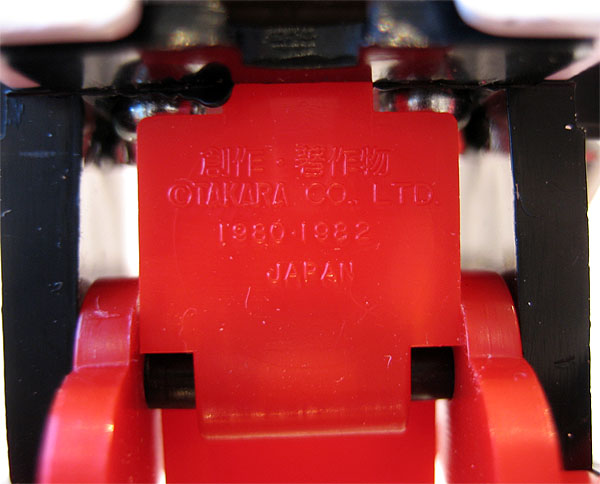
The Ceji Joustra series 1 Ambulance came first with TAKARA JAPAN in circle stamps and then updated with Kanji and dates on the copyright, however there were no noticeable changes made to the moulding of the toy. You can see both Joustra Ambulances (one of each stamping variant) here:
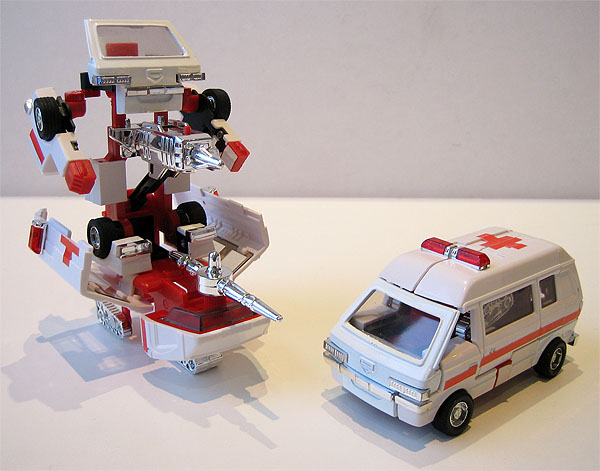
The above picture shows clearly how instantly displayable this toy is in either mode, and the below pictures demonstrate the difference between unapplied and applied stickersheet labels:
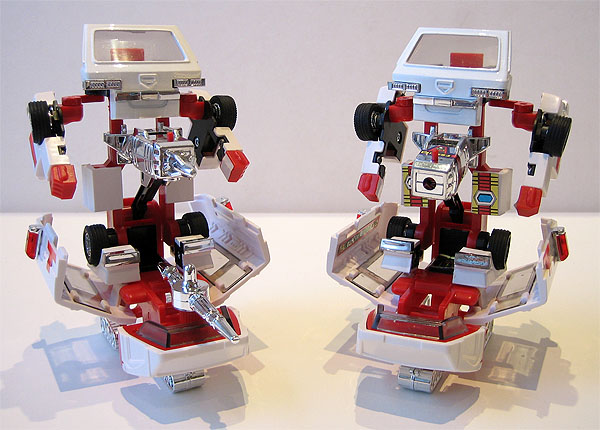
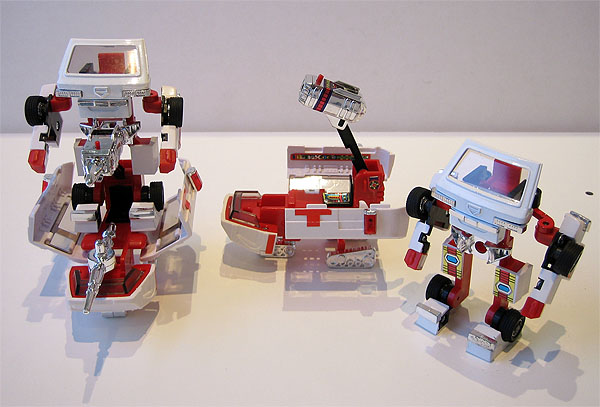
Quite the infirmary! You can see why this release would be appealing amongst all the other wave 1 Joustra characters, especially when you consider the role played by Ambulance in mini-comic chapter 7. The story featured so many different types of toys; Microchange cassettes, guns and minibots, Diaclone cars, jet, trucks and mecha. Going back to the stickers, I'm not really sure the stickersheet provides any serious augmentation to Ambulance's look, the black and red ribbon around the missile launcher is quite nice, but that's it. I quite like the undisturbed white/red/chrome look of the unused Ambulance.
To finish up, here is Paul Vromen's beautiful lineart for this article:
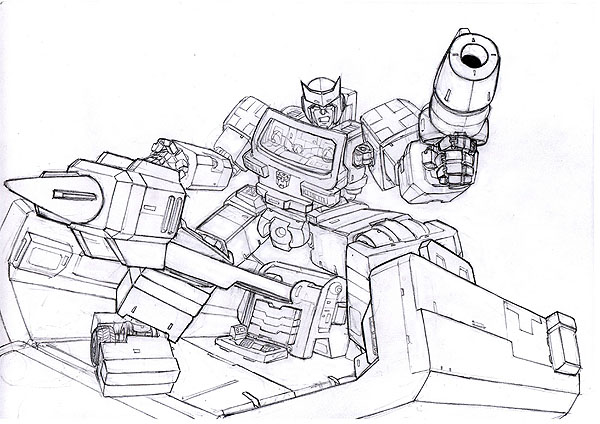
Finally, my Ceji Joustra Diaclone collection as of early June 2011, in which you can see the artwork for a Joustra Pick-Up (Gears) in vehicle mode just below that of the robot-mode artwork used for the same Pick-Up character on the Joustra Ambulance's box:
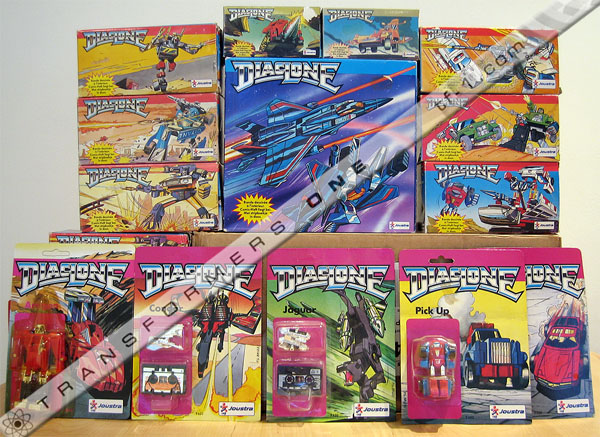
It is with a sense of great satisfaction that I close out this article, and it has nothing to do with my feelings on the content I have produced for this piece. My satisfaction comes entirely from the fact that I bought this Joustra Ambulance out of a sense of completion and for the stunning Brizzi artwork that takes these toys far beyond simply being "European Diaclones". I had never expected that on detailed inspection, and after a thorough going over I would appreciate this mould or this figure so much. It doesn't have a complicated transformation and it doesn't appeal to my original love of these toys through the Transformers vein, but I was just not prepared for how impressed I would be at how excellent this toy looked when fully decked out and in such pristine condition.
Factor in the role of this character in the Joustra War On Diaclona tapestry, the many packaging variants and interesting foreign releases of the Ambulance and Ratchet, and it becomes clear that even the most common members of a special toyline can have meaningful significance and a story to tell. Of course I am biased when I say that this Joustra version is my favourite of all the releases of the Onebox Ambulance mould. The Joustra Diaclone line just wouldn't be the same without it.
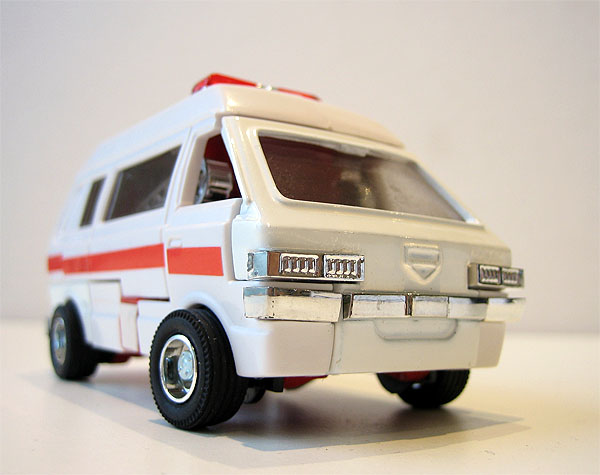
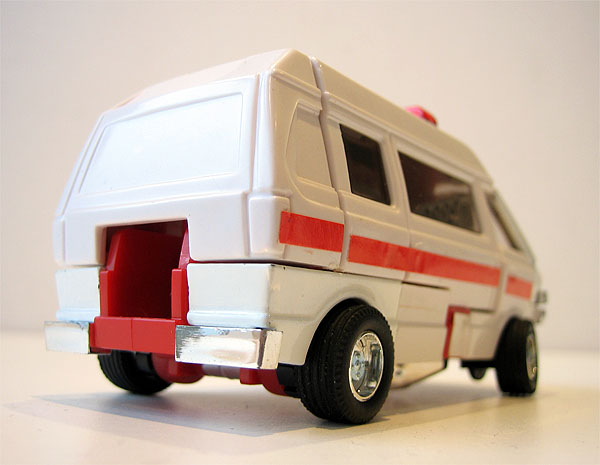
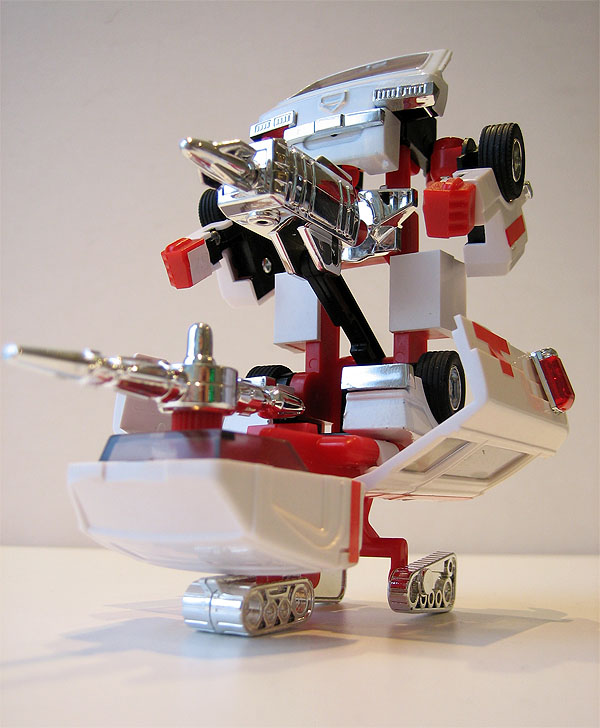
Heartfelt thanks to Mijo for the MB Ratchet pictures and his incredible Milton Bradley articles, to Quint Gremmen for his incredibly kind contribution of mailaway Ratchet pictures, to George "Weeter" Hubert for the GiG Ambulance shots, to Ben Munn for the MISB Ratchet picture, to Detour for help with comic translation and to Himawari for the Story of Diaclone magazine scan.
All the best
Maz@tf-1.com













